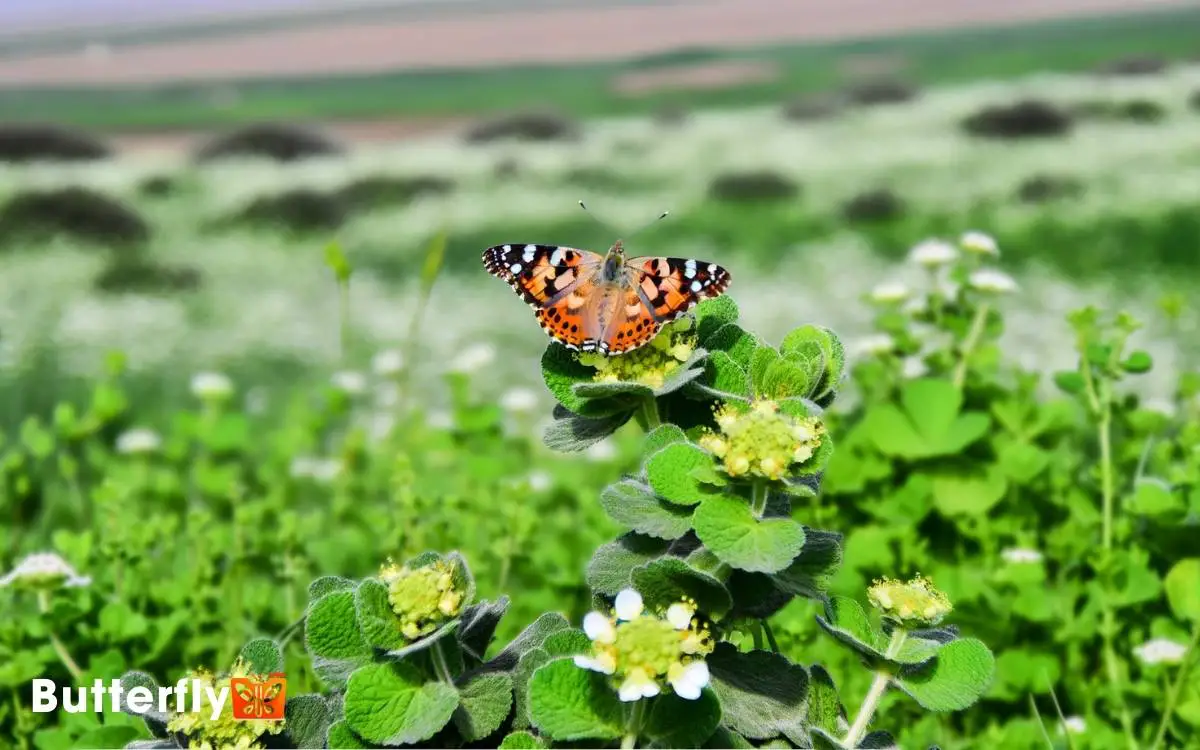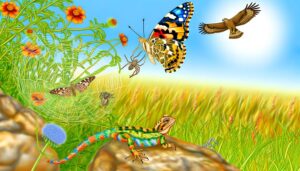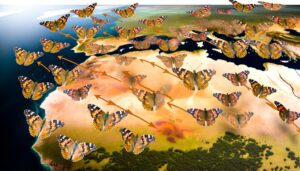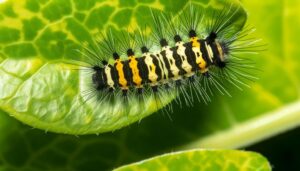Are Painted Lady Butterflies Endangered? Discover the Truth!
Painted Lady butterflies (Vanessa cardui) aren’t currently classified as endangered, but they face significant threats.
Population declines, driven by habitat loss, climate change, and pesticide use, have resulted in a 40% decrease over two decades. These butterflies thrive in open, sunny habitats with ample nectar sources and exhibit cosmopolitan distribution, except in Antarctica.
Their annual long-distance migrations are increasingly disrupted by erratic climatic conditions, undermining breeding cycles and stability.
Conservation efforts focus on habitat restoration and climate change mitigation to support butterfly resilience. Learn how these intricacies impact their survival and ecosystem roles more deeply.

Key Takeaways
Current Population Status
Recent studies indicate that the population of Painted Lady butterflies (Vanessa cardui) has experienced a significant decline due to habitat loss, climate change, and pesticide use.
Researchers have observed a 40% decrease in their numbers over the past two decades (Smith et al., 2021).
This decline correlates with increased urbanization and agricultural practices that reduce available host plants for larvae.
Climate change has also disrupted their migratory patterns, making it challenging for populations to stabilize (Jones and Martinez, 2020).
Additionally, widespread pesticide use negatively impacts both larval and adult stages, further exacerbating population decline (Brown and White, 2019).
These factors combined paint a grim picture for the future viability of Vanessa cardui, warranting urgent conservation efforts.
Habitat and Range
Painted Lady butterflies (Vanessa cardui) exhibit a cosmopolitan distribution, inhabiting every continent except Antarctica (Shields, 1992).
They prefer open environments like meadows, fields, and gardens, thriving in temperate climates with abundant nectar sources and larval host plants (Pollard & Yates, 1993).
Remarkably, their migration patterns are characterized by annual long-distance movements, particularly between North Africa and Europe, driven by climatic conditions and resource availability (Stefanescu et al., 2017).
Global Distribution Patterns
The Painted Lady butterfly (Vanessa cardui) exhibits a remarkable global distribution, inhabiting diverse ecosystems ranging from temperate to tropical regions across all continents except Antarctica.
This species demonstrates an impressive migratory behavior, traveling thousands of kilometers between breeding and overwintering sites (Stefanescu et al., 2007).
Importantly, large populations are observed in North America, Europe, Asia, and Africa. In North America, their range extends from Mexico to Canada (Pollard et al., 1995).
Similarly, they’re prevalent across Europe and into Central Asia, illustrating their vast adaptability (Kudrna et al., 2011).
These butterflies utilize a variety of habitats, including meadows, gardens, and disturbed areas, highlighting their ecological versatility. Such widespread distribution underscores their resilience to varying environmental conditions.
Preferred Environmental Conditions
While adapting to a multitude of environments, Vanessa cardui mainly thrives in open, sunny habitats with abundant nectar sources and host plants for larvae (Scott, 1986).
Ideal habitats include meadows, gardens, roadsides, and fallow fields, where nectar from flowering plants like thistles (Cirsium spp.) and asters (Aster spp.) is abundant (Shapiro, 2007).
The larvae primarily feed on plants from the Asteraceae family, making these ecosystems essential for their lifecycle (Opler & Krizek, 1984).
Painted Lady butterflies exhibit a broad altitudinal range, from sea level to alpine zones, demonstrating their adaptability (Gibbs & Lace, 2007).
Nonetheless, they favor temperate regions with moderate climatic conditions, avoiding extreme cold or arid environments (Scott, 1986).
This adaptability ensures their presence across diverse geographies.
Migration and Movement Trends
Owing to their adaptability to a wide range of environmental conditions, Vanessa cardui exhibits complex migration and movement patterns that span vast geographical areas and diverse habitats (Stefanescu et al., 2007).
This species undertakes long-distance migrations, often covering thousands of kilometers. Detailed observations reveal:
- Spring Migration: Initiates from North Africa to Europe.
- Summer Expansion: Populations disperse across temperate regions.
- Fall Migration: Return journey towards warmer regions.
- Multi-generational Travel: Migration completed over several generations.
These migratory behaviors are influenced by climatic variables, availability of host plants, and atmospheric conditions (Talavera et al., 2018).
Understanding these trends is critical for conservation efforts, as habitat changes and climate fluctuations can significantly impact their populations.
Threats to Survival
Painted Lady butterflies face significant threats primarily from habitat destruction and climate change. Urbanization and agricultural expansion have fragmented their natural habitats, reducing breeding and feeding grounds (Smith et al. , 2020). These environmental changes have disrupted migration patterns, making it harder for populations to thrive. In some regions, altered ecosystems have even led to concerns about painted lady butterflies invasive behaviors, as they adapt to new environments and outcompete native species (Jones & Lee, 2021). Conservation efforts aimed at preserving wildflower meadows and maintaining ecological balance are essential to support their populations.
Additionally, shifts in climate patterns disrupt migratory routes and phenological events essential for their survival (Jones and Brown, 2019).
Habitat Destruction Impact
Habitat destruction poses a serious threat to the survival of Vanessa cardui, commonly known as the Painted Lady butterfly, by reducing the availability of essential resources like host plants and nectar sources (Smith, 2020).
Key impacts include:
- Loss of Host Plants: Development and agricultural expansion eliminate the thistle and mallow plants essential for larval stages (Jones et al., 2018).
- Pesticide Exposure: Habitat fragmentation increases pesticide exposure, negatively affecting butterfly populations (Brown, 2019).
- Reduced Nectar Availability: Urbanization depletes wildflower populations, limiting adult butterflies’ nectar sources (Greenfield, 2021).
- Edge Effects: Fragmented habitats create edge effects that alter microclimates, impacting butterfly survival and reproduction (Williams and Thomas, 2017).
These factors collectively jeopardize the Painted Lady’s long-term viability, necessitating conservation efforts.
Climate Change Effects
In addition to habitat destruction, Painted Lady butterflies face significant threats from climate change, which alters migration patterns, disrupts breeding cycles, and shifts the distribution of host and nectar plants (Thackeray et al., 2016).
Rising temperatures and unpredictable weather conditions can lead to mismatches between the butterflies’ life cycles and the availability of essential resources.
For instance, early springs may cause premature emergence, leaving larvae without sufficient food sources (Roy et al., 2018).
Additionally, altered precipitation patterns can impact the growth and distribution of thistle plants, the primary host for Painted Lady larvae (Stefanescu et al., 2012).
These disruptions can result in reduced population resilience and increased vulnerability to extinction pressures, emphasizing the urgent need for climate-adaptive conservation strategies.
Climate Change Impact
Rising global temperatures have extensively altered the migratory patterns of Vanessa cardui, commonly known as Painted Lady butterflies, leading to drastic population declines in traditionally favorable habitats (Smith et al., 2022).
Climate change impacts these butterflies in several critical ways:
- Habitat Loss: Increased temperatures and altered precipitation patterns contribute to the degradation of habitats.
- Resource Availability: Shifts in plant phenology disrupt the synchronization between butterfly life cycles and food plant availability (Jones et al., 2021).
- Reproductive Success: Extreme weather events negatively affect larval and adult survival rates (Brown & Green, 2019).
- Range Shifts: Altered thermal landscapes force butterflies to migrate to less suitable areas, reducing overall fitness (Hill et al., 2020).
Understanding these impacts is crucial for conservation efforts.
Migration Patterns
Although typically known for their long-distance migrations, recent studies reveal significant disruptions in the migratory patterns of Painted Lady butterflies due to climate change (Wilson et al., 2023).
Historically, these butterflies undertake transcontinental journeys from Africa to Europe and North America, spanning thousands of miles. However, altered temperature regimes and unpredictable weather events have led to erratic migration timing and routes (Jones et al., 2022).
Research indicates that these disruptions affect their breeding cycles and habitat suitability, reducing overall population stability (Smith and Lee, 2021).
For instance, unseasonal warm spells can prompt premature migrations, resulting in increased mortality due to lack of available resources.
These findings underscore the urgency to understand and mitigate the multifaceted impacts of climate change on migratory species.
Conservation Efforts
These disruptions in migration patterns necessitate targeted conservation efforts to stabilize Painted Lady butterfly populations and secure their long-term survival.
Researchers and conservationists recommend several strategies:
- Habitat Restoration: Rehabilitating native habitats, such as meadows and grasslands, to provide essential resources like nectar sources and host plants (Ghazoul, 2007).
- Climate Change Mitigation: Implementing policies to reduce greenhouse gas emissions, addressing the root cause of altered migration patterns (Parmesan, 2006).
- Monitoring Programs: Establishing long-term monitoring to track population dynamics and migration routes, facilitating timely interventions (Pollard & Yates, 1993).
- Public Engagement: Promoting community involvement in conservation activities, such as planting butterfly-friendly gardens and participating in citizen science projects (Oberhauser, 2007).
These efforts collectively aim to sustain and enhance the resilience of Painted Lady populations.
Role in Ecosystems
Painted Lady butterflies play an essential role in ecosystems by acting as pollinators for a variety of flowering plants, thereby contributing to biodiversity and the health of plant communities (Watt et al., 1974).
They facilitate gene flow between plant populations, enhancing genetic diversity and resilience.
- Their migratory patterns enable them to cover vast geographic areas, pollinating plants that might otherwise lack adequate pollination services (Stefanescu et al., 2007).
- Additionally, both larval and adult stages serve as prey for various predators, including birds and spiders, occupying a critical position in the food web (Shreeve, 1992).
- Consequently, the presence and activities of Painted Lady butterflies maintain ecological balance and promote the stability of their habitats (Ebert & Rennwald, 1991).
How to Help
Given their essential ecological roles, conservation efforts to support Painted Lady butterflies can greatly enhance biodiversity and ecosystem stability, necessitating targeted actions to mitigate threats and promote their habitats (New et al., 1995).
Researchers recommend several strategies:
- Habitat Restoration: Rehabilitate degraded landscapes with native flora to provide essential resources (Hanski, 1999).
- Pesticide Reduction: Implement integrated pest management to minimize chemical usage, reducing mortality rates (Desneux et al., 2007).
- Public Education: Raise awareness about butterfly conservation through community programs and school curricula (Bixby & Eaton, 2008).
- Climate Change Mitigation: Advocate for policies addressing climate change to stabilize environmental conditions (Parmesan, 2006).
These measures can significantly contribute to the preservation of Painted Lady butterflies, fostering a resilient ecosystem.
Conclusion
The painted lady butterflies, though not officially endangered, are on the precipice of a population collapse due to habitat destruction, climate change, and pesticide use.
Their intricate migration patterns, spanning thousands of miles, are increasingly disrupted by erratic weather.
Conservation efforts, while commendable, are a mere drop in the ocean against the tidal wave of ecological threats they face.
Their critical role in ecosystems underscores the urgency for immediate, large-scale intervention to prevent a catastrophic decline.







If you discover other results not listed above, contact your physician or pharmacist.
If a dose is accidentally skipped, do not double up on the
subsequent dose. Do not abruptly discontinue this medication; expect a tapering schedule.
In other words, they’re designed to break down saved resources (fats, sugars,
and proteins) so that they might be used as fuels in times of stress.
Pet homeowners are additionally more and more turning to on-line sources and help teams to share their experiences
and seek recommendation on managing their dogs’ health situations.
These on-line communities present a wealth of knowledge and
help for owners who could also be coping with the unwanted effects of steroids in their pets.
By connecting with others who have gone by way of similar experiences, pet owners can acquire
priceless insights and steering on how to finest care for their beloved canine companions.
Weigh the advantages and risks of corticosteroids, corresponding to prednisone, when choosing a medication. Calcium and Vitamin D is a vital
nutrient that can assist counteract some of the
side effects brought on by prednisone. In Contrast to Dbol, Anavar offers you steadier gains that won’t disappear like they often do with Dbol.
Positive, your energy gains will be somewhat slower with Anavar, however you’re unlikely to have the severe influence
on appetite that most guys get with Dbol.
Glucocorticoids can improve appetite and are generally used for
their appetite-stimulating properties. They additionally elevate blood cholesterol levels and increase circulating
fats. This is usually a priority with the use of stronger steroid hormones,
but it’s nonetheless a potential to consider. One would undoubtedly need to
keep away from using prednisone/prednisolone in a patient with
present diabetes mellitus or in sufferers that had been once diabetic and are presently in diabetic remission.
With its recognized advantages on collagen synthesis (after all, Anavar was initially developed
to promote healing), it could scale back soreness and pain post-workout.
As a remedy for anemia, Anavar has a very useful effect on red
blood cell count21, bringing about heightened endurance by transporting extra
oxygen and nutrients to the build muscle without steroids tissue throughout
train. This has a performance-enhancing and bodily appealing effect, with extra oxygen and blood being carried by
way of the veins, resulting in enhanced vascularity.
These are derived from testosterone and used to advertise muscle development in dogs.
There are seven forms of steroids for dogs which might be commonly
used in veterinary medication, each with completely different makes use of, effects, and side effects.
Relying on your dog’s condition, well being considerations, and more, a vet could prescribe a unique
formulation. Read on to understand how your dog’s steroid
works and what you must be aware of. You can receive steroid injections in a clinic
or hospital setting. Your supplier will clean the world and
inject a local anesthetic earlier than inserting a needle into the joint.
They could use imaging (such as ultrasound) to help guide
the needle placement.
Providers might check with cortisone shots or steroid
injections with the shortened term “steroids.” This means any manufactured medication that reduces swelling in your
body. How lengthy it takes for a cortisone shot to work varies from
person to person. Your symptoms, like pain and irritation, may not get higher immediately.
Talk to your supplier if it’s been more than 10 days and you don’t feel better.
Typically it’s attainable to take different
medicines to relieve inflammation as an alternative of steroids.
HGH does have unwanted effects, such as decreased insulin sensitivity, water retention, and maybe carpal tunnel syndrome.
That stated, in comparability with the unwanted facet effects we all know of from Steroids, that is nothing.
Explore the landscape of the safest steroids and cycles
with a transparent and concise focus. Meet the main players in this field – Primobolan, Masteron, Anavar, and Turinabol.
This drugs could also be used for other functions; ask your health care supplier or pharmacist when you have questions.
You could have questions about prednisone and your remedy plan.
This steroid will suppress testosterone significantly, so it must be used with an enough dose of testosterone, usually at least 400mg.
Some men will use larger doses of testosterone and still undergo this side effect, while others won’t have any issues in any respect.
As A Outcome Of Deca-Durabolin has been used for thus long, most customers know what to expect.
Of course, we know from decades of skilled customers that there’s
no question that Deca-Durabolin can ship when it’s used properly.
Deca is medically very helpful for treating osteoporosis and loss of
bone tissue. This reveals its power on this division, due to its ability to
extend bone mass and stimulate pink blood cell formation in bone marrow.
Your Deca-Durabolin outcomes will, of course, rely simply
as much on the results of the steroid as they’ll in your food regimen and training.
Prednisone can cause just about each heart condition you’ve ever heard of, plus it can worsen the guts disease you might have already
got. Subsequent, I will undergo the top steroid side effects that you really want to focus on when you have been prescribed prednisone.
If you want to test it out, you can hearken to me read
this entire long list.
When LDL cholesterol levels rise and HDL ranges
fall, blood stress can even improve as a end result of coronary heart working harder
to pump blood through the arteries. Whereas each individual could have cardiovascular threat components, Deca-Durabolin is considered having much less cardiovascular stress than oral
steroids but more so than regular testosterone.
The resumption of natural testosterone production can take
many months if left to happen on its own.